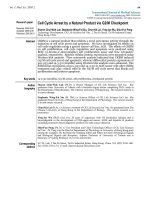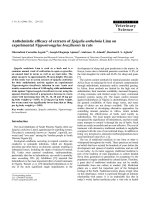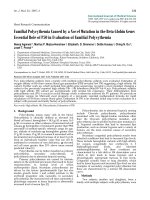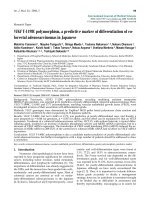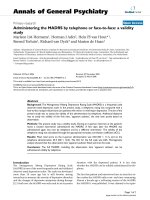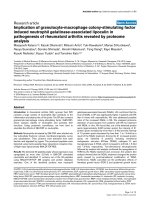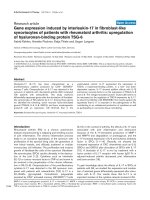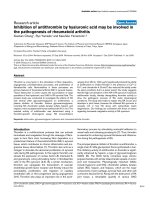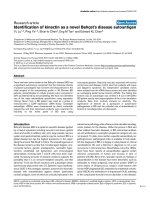Báo cáo y học: "Aerosolised surfactant generated by a novel noninvasive apparatus reduced acute lung injury in rats" doc
Bạn đang xem bản rút gọn của tài liệu. Xem và tải ngay bản đầy đủ của tài liệu tại đây (1.09 MB, 9 trang )
Open Access
Available online />Page 1 of 9
(page number not for citation purposes)
Vol 13 No 2
Research
Aerosolised surfactant generated by a novel noninvasive
apparatus reduced acute lung injury in rats
Yu Sun
1
, Rui Yang
1
, Ji-gen Zhong
1
, Feng Fang
2
, Jin-jin Jiang
2
, Ming-yao Liu
3
and Jian Lu
1
1
Department of Pathophysiology, College of Basic Medical Sciences, Second Military Medical University, 800 Xiangyin Road, Shanghai, 200433,
China
2
Department of Pediatrics, Changhai Hospital, Second Military Medical University, 800 Xiangyin Road, Shanghai, 200433, China
3
Latner Thoracic Surgery Research Laboratories, University Health Network, Toronto General Research Institute and Department of Surgery, Faculty
of Medicine, University of Toronto, TMDT/MaRS East Tower – 13th Floor, Room 707, 101 College Street, Toronto, Ontario, Canada M5G 1L7
Corresponding author: Jian Lu,
Received: 19 Nov 2008 Revisions requested: 6 Jan 2009 Revisions received: 23 Feb 2009 Accepted: 4 Mar 2009 Published: 4 Mar 2009
Critical Care 2009, 13:R31 (doi:10.1186/cc7737)
This article is online at: />© 2009 Sun et al.; licensee BioMed Central Ltd.
This is an open access article distributed under the terms of the Creative Commons Attribution License ( />),
which permits unrestricted use, distribution, and reproduction in any medium, provided the original work is properly cited.
Abstract
Introduction Exogenous surfactant has been explored as a
potential therapy for acute lung injury (ALI) and acute respiratory
distress syndrome (ARDS). In the present study, a nebuliser
driven by oxygen lines found in the hospital was developed to
deliver aerosolised porcine pulmonary surfactant (PPS). We
hypothesised that aerosolised surfactant inhaled through
spontaneous breathing may effectively reduce severe lung
injury.
Methods Rats were intravenously injected with oleic acid (OA)
to induce ALI and 30 minutes later they were divided into five
groups: model (injury only), PPS aerosol (PPS-aer), saline
aerosol (saline-aer), PPS instillation (PPS-inst), and saline
instillation (Saline-Inst). Blood gases, lung histology, and protein
and TNF-α concentrations in the bronchoalveolar lavage fluid
(BALF) were examined.
Results The PPS aerosol particles were less than 2.0 μm in size
as determined by a laser aerosol particle counter. Treatment of
animals with a PPS aerosol significantly increased the
phospholipid content in the BALF, improved lung function,
reduced pulmonary oedema, decreased total protein and TNF-α
concentrations in BALF, ameliorated lung injury and improved
animal survival. These therapeutic effects are similar to those
seen in the PPS-inst group.
Conclusions This new method of PPS aerosolisation combines
the therapeutic effects of a surfactant with partial oxygen
inhalation under spontaneous breathing. It is an effective, simple
and safe method of administering an exogenous surfactant.
Introduction
Exogenous surfactants have been routinely used to treat pre-
term infants with neonatal respiratory distress syndrome
(NRDS), reduce alveolar atelectasis, improve oxygenation and
stabilise the status of the lung fluid system [1]. Surfactant
administration has also been attempted for the treatment of
adults with acute lung injury (ALI) or acute respiratory distress
syndrome (ARDS) [2,3]. Instillation of bolus exogenous sur-
factant into the airway through endotracheal intubation or
bronchoscopy is the conventional way of administering sur-
factant; however, this method can be associated with compli-
cations, such as bradycardias, changes in blood pressure,
drug reflux and the need to re-intubate [4-10].
Inhaling an aerosolised surfactant is another method of exog-
enous surfactant administration [11,12]. Ultrasonic or jet neb-
ulisers have been used to generate aerosolised surfactant.
Although these approaches have proven to be efficient and
safe in animal models [13-15], the therapeutic effects of aero-
solised surfactant in human clinical trials have not been con-
vincing. Most ultrasonic or jet nebulisers require the patient to
have mechanical ventilation to deliver aerosolised surfactants,
however, the improper use of ventilators may cause or
ALI: acute lung injury; ARDS: acute respiratory distress syndrome; BALF: bronchoalveolar lavage fluid; BSA: bovine serum albumin; ELISA: enzyme-
linked immunosorbent assay; H&E: haematoxylin & eosin; NRDS: neonatal respiratory distress syndrome; OA: oleic acid; PaO
2
: partial pressure of
oxygen in arterial blood; PaCO
2
: partial pressure of carbon dioxide in arterial blood; PPS: porcine pulmonary surfactant; TNF: tumour necrosis factor.
Critical Care Vol 13 No 2 Sun et al.
Page 2 of 9
(page number not for citation purposes)
enhance lung injury [16-18]. Recently, an aerosolised sur-
factant delivered by continuous positive airway pressure
(CPAP) has shown beneficial effects in the treatment of NRDS
without the need for mechanical ventilation [19-22]. These
interesting results suggest that aerosolised surfactants
inhaled by spontaneous breathing may be an alternative
method of surfactant-based therapies.
Our previous studies demonstrated that intra-tracheal instilla-
tion of porcine pulmonary surfactant (PPS) reduced ALI in a
variety of animal models [23-25]. In the present study, we have
developed a new noninvasive method to deliver aerosolised
surfactant. We hypothesised that aerosolised surfactant
inhaled by spontaneous breathing may effectively reduce
severe lung injury. The effects of aerosolised PPS delivered by
this new method were evaluated in a rat model with severe ALI
induced by oleic acid (OA).
Materials and methods
Surfactant preparation
PPS was isolated from pig bronchoalveolar lavage fluid
(BALF) using a protocol modified from the one used by
Enhorning and colleagues [26]. Briefly, PPS was extracted
from BALF using sequential centrifugation, chloroform-metha-
nol extraction and acetone precipitation. PPS contains more
than 90% phospholipids and about 1% hydrophobic protein,
mainly surfactant protein B and C. It is approved for use in clin-
ical trials of NRDS treatments by the State Food and Drug
Administration of China.
Acute lung injury model and experimental design
This study was approved by the Institutional Ethics Committee
(protocol No. M2008-004/20080123), following the guide-
lines of the National Institutes of Health for the care and use of
laboratory animals. Male Sprague-Dawley rats (weighing 200
to 250 g) had their food withheld for 24 hours but were
allowed free access to water. All animals were anaesthetised
with intraperitoneal pentobarbital sodium (30 mg/ml; 0.25 ml
per animal; additional doses of 0.1 ml when necessary; Grin-
sted Products, Brabant, Denmark). One carotid artery was
cannulated and flushed with heparinised saline (100 u/ml) to
collect samples for blood gas analysis.
ALI was induced using 20% OA (Second Chemical Agent
Factory, Yixing, China) diluted with 0.1% BSA. All animals
received a 1.0 ml/kg diluted OA injection (using a syringe with
a No. 4.5 pedo-scalp needle) through a lingual vein for one
minute. Rats were divided into five groups: PPS aerosol (PPS-
aer, n = 16), saline aerosol (saline-aer, n = 16), PPS instillation
(PPS-inst, n = 10), saline instillation (saline-inst, n = 10) and
model (injury only, n = 10) groups.
Administration of surfactant
The nebuliser was driven by an oxygen line in the hospital ward
and the flow rate used was 4.0 L/minute. When used clinically,
the nebuliser can be connected to a facemask (Figure 1a);
however, in the present experiment the anaesthetised rat was
placed into a plastic container 30 minutes after the injection of
OA. At the bottom of the container was a plastic plate, the
anterior part of which was connected to the nozzle of a PARI
LCD nebuliser (Pari Respiratory Equipment, Germany; Figure
1b). At the start of the experiment, the nebuliser was filled with
a 20 mg/ml diluted PPS suspension given at a dose of 20 ml/
kg. The first dose of PPS was nebulised over 20 minutes fol-
lowed by 2 ml of saline nebulised over the next 10 minutes.
This procedure was then repeated, giving a total amount of
aerosolised PPS of 800 mg/kg. After the aerosol treatment,
the animal was removed from the container and monitored
until the end of the experiment. For the saline-aer group, an
identical volume of saline was substituted for the PPS suspen-
sion. Animals were allowed to breath normally throughout the
Figure 1
Experimental device for surfactant aerosol deliveryExperimental device for surfactant aerosol delivery. (a) A nebuliser is connected to an oxygen line and porcine pulmonary surfactant (PPS) in the
nebuliser is converted to an aerosol by the jetting power of oxygen. (b) An anesthetised rat is placed in the plastic container and allowed to inhale
the PPS aerosol by spontaneous breathing.
Available online />Page 3 of 9
(page number not for citation purposes)
experiment except for the during the one hour of aerosolisa-
tion.
The rats in the PPS-inst and saline-inst groups were intubated
after tracheotomy performed before OA injection. The rats in
the PPS-inst group were instilled with 50 mg/ml PPS at a dose
of 2 ml/kg via the endotracheal tube, and the saline-inst group
was instilled with the same volume of saline. After instillation of
PPS or saline, the lungs were filled with 2 ml of air four times.
Assessment of surfactant treatment on acute lung injury
Arterial blood samples were taken before and every 30 min-
utes for four hours after the injection of OA. Arterial partial
pressure of oxygen (PaO
2
), arterial partial pressure of carbon
dioxide (PaCO
2
) and pH were measured with a DH-1830G
blood gas analyser (Experimental Medical Apparatus Co.,
Nanjing, China). Respiratory rates were monitored at the time
of blood sampling. At the end of the experiment, the survival
rate of the rats was calculated. The animals were then sacri-
ficed by exsanguination, and the lungs were removed and
weighed. The lung index was calculated as the ratio of the wet
lung weight to the body weight of the rat. Bronchoalveolar lav-
age was performed by lavaging 3 ml ice cold saline into the
right lung. The lavage was repeated three times with about
90% of lavage fluid being recovered. The lavage fluid was
immediately cooled to 4°C and centrifuged at 150 gfor 10
minutes. The total protein content and TNF-α concentration in
the supernatant of BALF were measured with Lowry's protein
assay and an ELISA kit (BioSource, Carlsbad, CA, USA),
respectively. The left lung was expanded with air under 10
cmH
2
O pressure, fixed in 10% formalin and prepared for his-
tological examination.
Measurement of the particle size of aerosolised
surfactant in vitro
A surfactant aerosol was diluted with air in a dilution bottle and
the density of the surfactant aerosol was monitored with a
laser aerosol particle counter (BCJ-1D; Institute of Optics and
Fine Mechanics, Shanghai, China) and an oscilloscope (Model
F123; Industrial Scopemeter, FLUKE Corporation, Everett,
WA, USA). The size distribution of aerosolised surfactant in
the dilution bottle was tested at three different flow rates (2.0,
4.0 and 8.0 L/minute).
Surfactant phospholipid analysis in BALF
Lipids were extracted from the BALF of rats in the PPS-aer and
saline-aer groups, and from a sham-operated normal control
group using the method of Furue and colleagues [27]. The
phospholipids were separated by thin-layer chromatography
on pre-coated activated silica-gel type 60G plates. The plates
were developed in a mixture of chloroform, methanol and water
(at a ratio of 65:25:4, v/v). By exposure of the plates to I2
vapour, the lipids on the chromatograms were visualised and
the spots of surfactant phospholipid on the plate were opti-
cally scanned.
Histological examination
The lung sections were stained with H&E and examined with
light microscopy. Lung injury was scored in a blinded fashion.
Hyperaemia, atelectasis and neutrophil infiltration were scored
as: 0 = minimal; 1 = mild; 2 = moderate; 3 = severe; 4 = max-
imal. Intra-alveolar oedema was scored as: 0 = absent; 1 =
present.
Statistical analysis
SPSS 12.0 statistical software (SPSS Inc, Chicago, IL, USA)
was used. Data were analysed using the following tests: chi
squared analysis for survival rates, Kruskal Wallis H test for
histological data and one-way analysis of variance for multiple
comparisons followed by Dunnett's test. P values of 0.05 or
less were considered significant.
Results
Particle size of PPS aerosol
The size of the surfactant aerosol was measured three times at
each flow rate (2.0, 4.0 and 8.0 L/minute) and the mean values
and integrated count were obtained (Table 1). With a flow rate
of 2.0 L/minute, 90.7% of the particles were smaller than 2.0
μm in diameter, although when the flow rates were more than
4.0 L/minute, almost all particles were smaller than 2.0 μm.
Table 1
Size distribution of porcine pulmonary surfactant aerosol particles
Particle diameter (μm) Flow rate (L/minute)
2.0 4.0 8.0
MV IC MV IC MV IC
≤ 2.0 90.7% 90.7% 99.8% 99.8% 100.0% 100.0%
2.0 to 5.0 2.3% 93.0% 0.2% 100.0% 0.0% 100.0%
≥ 5.0 7.0% 100.0% 0.0% 100.0% 0.0% 100.0%
IC = integrated count from three repeated measures; MV = mean value.
Critical Care Vol 13 No 2 Sun et al.
Page 4 of 9
(page number not for citation purposes)
The flow rate used clinically for oxygen delivery ranges from 3
to 5 L/minute, so most surfactant aerosol particles generated
by this method should be 2.0 μm or smaller.
Inhalation of PPS aerosol increased phospholipid
content in BALF
We measured the phospholipid content in BALF using thin-
layer chromatography. After injection of OA, phospholipids in
the BALF of the saline-aer group significantly decreased, and
the phosphatidylcholine content was only 54 ± 4.5% of that in
the sham-operated group (P < 0.01; mean ± standard devia-
tion). The phosphatidylcholine content in the BALF of the PPS-
aer group was 85 ± 4.2% of that in the sham-operated group.
This is significantly higher than that found in the saline-aer
group (P < 0.05; mean ± standard deviation; Figures 2a, b).
Inhalation of surfactant aerosol restored the loss of phosphol-
ipids in the lung.
Aerosolised PPS improved the oxygenation function of
the lung and decreased respiratory rates
After OA injection, the PaO
2
rapidly dropped from 110 to 64
mmHg (Figures 3a, b). Instillation of PPS (PPS-inst group) led
to a gradual increase of PaO
2
to about 110 mmHg after three
hours (Figure 3a). The PaO
2
in the PPS-aer group quickly
increased to about 110 mmHg within one hour of PPS aesoli-
zation (Figure 3b). The PaO
2
values in both the PPS-inst and
PPS-aer groups were higher when compared with the model
group after treatment (P < 0.05). The PaO
2
values of the
saline-aer group were also higher than those of the model
group, although the differences were not statistically signifi-
cant. The values of PaCO
2
and pH among the groups showed
no significant differences (data not shown).
Injection of OA accelerated respiratory rates from 70 to 80
breaths/minute to 140 to 150 breaths/minute in both the
model and saline-inst groups. This acceleration was seen in
these groups until the end of the experiment. In the PPS-inst
group, tachypnoea induced by the OA injection returned to
baseline (70 to 80 breaths/minute) within one hour of the
treatment (Figure 3c). Inhalation of aerosolised saline
decreased the respiratory rates in the saline-aer group to 100
breaths/minutes within one hour. The respiratory rates in the
PPS-aer group were similar to the PPS-inst group, and
returned to baseline (70 to 80 breaths/minute) within one hour
(Figure 3d).
Aerosolised PPS reduced lung oedema and
inflammatory responses in the lung
As shown in Figure 4, a significantly decreased lung index
(lung/body weight ratio; Figure 4a) and total protein content in
BALF (Figure 4b) were observed in the PPS-aer and PPS-inst
groups when compared with the model group and both
groups that received saline (P < 0.01). ALI has been attributed
to an excessive inflammatory response in the lung and treat-
ment with exogenous surfactant significantly decreases the
levels of pro-inflammatory cytokines [28]. TNF-α concentration
in the BALF of the rats in the PPS-aer and PPS-inst groups
was significantly reduced when compared with the model
group and both groups that received saline (P < 0.01, Figure
4c).
The lungs in the model group and both groups that received
saline appeared grossly swollen with diffuse haemorrhage in
the lung tissue and pink exudates from the airway. Mean lung
injury scores were significantly lower in the PPS-inst and PPS-
aer groups than in the other groups (P < 0.05; Table 2). In par-
ticular, a reduction of intra-alveolar and interstitial oedema, and
Figure 2
Inhalation of surfactant aerosol restored the phospholipid content in bronchoalveolar lavage fluid of rats with acute lung injury induced by oleic acidInhalation of surfactant aerosol restored the phospholipid content in
bronchoalveolar lavage fluid of rats with acute lung injury induced by
oleic acid. (a) Phospholipids in the bronchoalveolar lavage fluid (BALF)
separated by two-dimensional thin-layer chromatography. (b) Aero-
solised surfactant restored phosphatidylcholine (PC) contents in BALF.
Mean ± standard deviation from six animals per group. * P < 0.01 com-
pared with the sham group.
#
P < 0.05 compared with the saline-aer
group. PPS = porcine pulmonary surfactant.
Available online />Page 5 of 9
(page number not for citation purposes)
reduced haemorrhage and atelectasis were observed in the
lung tissue of the PPS-treated groups (Figure 5).
Effects of PPS aerosol on survival
The survival rate in both the model and saline-inst groups was
70%. Three of the 16 rats in the saline-aer group died
(81.25%) during the study, whereas the survival rate in both
the PPS-aer and PPS-inst groups was 100% (P < 0.05, vs.
the model and saline-inst groups; Table 3).
Discussion
In the present study, we have developed a new noninvasive
method of generating and delivering surfactant aerosol with a
simplified nebulisation device driven by the oxygen line used in
hospitals. We demonstrated the therapeutic effects of PPS
aerosol on a rat model with OA-induced ALI.
The efficacy of aerosol delivery depends on the particle size.
The average particle size of surfactant aerosols generated by
ultrasonic or jet nebulisers is between about 4.5 and 3.5 μm,
respectively [29,30]. In the present study, about 99.8% of the
particles generated by our method at a flow rate of 4.0 L/
minute were smaller than 2.0 μm, based on our calibration
studies. It has been suggested that a particle size of 1 to 2 μm
provides the best delivery of aerosols to lung peripheral
regions. Particles between 2 and 6 μm in diameter are depos-
Figure 3
PPS administration improved recovery of PaO
2
and decreased respiratory rates after acute lung injury was induced with oleic acidPPS administration improved recovery of PaO
2
and decreased respiratory rates after acute lung injury was induced with oleic acid. (a) Arterial partial
pressure of oxygen (PaO
2
) in instillation groups. (b) PaO
2
in aerosolisation groups. (c) Respiratory rates in instillation groups. (d) Respiratory rates in
aerosolisation groups. Mean ± standard deviation with different number of animals per group: model and saline-inst groups (n = 7), PPS-inst group
(n = 10), saline-aer group (n = 13) and PPS-aer group (n = 16). * P < 0.05 compared with the model group. B = baseline; M = model, 30 minutes
after oleic acid injection and the beginning of treatments; PPS = porcine pulmonary surfactant.
Critical Care Vol 13 No 2 Sun et al.
Page 6 of 9
(page number not for citation purposes)
ited in the central airways and those above 6 μm are deposi-
tied in the oropharynx [31]. A study by Minocchieri and
colleagues in preterm infants showed that budesonide parti-
cles of 1.6 μm in diameter were optimal, with the lowest
impaction and drug losses in the upper airways [32]. Although
small particles might penetrate more deeply into the lung, they
are also less affected by gravity and are more apt to be exhaled
[31,33]. It is unknown how much of the inhaled surfactant par-
ticles were exhaled; however, we found a significantly
increased phospholipid content in the BALF and a therapeutic
effect on ALI in the PPS-aer group. These results indicated
that at least some of the inhaled surfactant particles were
deposited in the lungs. In future studies it will be necessary to
estimate how much PPS is delivered into the lungs.
After injection of OA, respiratory rates increased from 70 to 80
breaths/minute to 140 to 150 breaths/minute and gradually
returned to baseline within one hour in the PPS-aer group (Fig-
ure 3d). The average respiratory rate was about 110 to 120
breaths/minute during the one hour after aerosol administra-
tion. Assuming a tidal volume of 1.25 ml in rats weighing 200
to 250 g, the average passive minute volume should be about
140 to 150 ml/minute (1.25 ml × (110 to 120) breaths/minute
= 140 to 150 ml/minute). As the flow rate of oxygen was 4.0
L/minute, about 3.5 to 3.8% of the total output of the nebuliser
should have been inhaled by the rats. Other researchers have
reported that about 4% of a radio-labelled surfactant aerosol,
generated by nebulisers, reached the lung parenchyma with
therapeutic effects on ALI [34-38]. Based on this estimation,
Figure 4
Exogenous surfactant reduced pulmonary oedema and inflammatory responseExogenous surfactant reduced pulmonary oedema and inflammatory response. (a) Lung index (lung/body weight ratio), (b) total protein contents
and (c) TNF-α concentration in bronchoalveolar lavage fluid (BALF). Mean ± standard deviation in animals in the model and saline groups (n = 7)
and in the porcine pulmonary surfactant (PPS) groups (n = 10). * P < 0.01 compared with the model group.
$
P < 0.01 compared with the saline-
inst group.
#
P < 0.01 compared with the saline-aer group. Aer = aerosolisation; Inst = intra-tracheal instillation.
Available online />Page 7 of 9
(page number not for citation purposes)
about 25 mg/kg surfactant aerosol should have been depos-
ited in the lungs. Obviously, this amount is much lower than the
dose of surfactant given in the PPS-inst group (100 mg/kg).
One plausible explanation is that the surfactant aerosol may
have more success reaching the parenchyma of the lung, even
in the presence of severe lung injury, than the bolus instillation
of surfactant suspension.
It has been reported that administration of exogenous sur-
factant may not only prevent the lung from oedema by stabilis-
ing the fluid system in the lung, but may also inhibit the
inflammatory response [28]. In this study, we showed a thera-
peutic effect of aerosolised PPS on OA-induced ALI, including
reduced lung oedema, decreased total protein content and
TNF-α concentration in BALF, ameliorated lung injury and
increased survival rate. Aerosolisation of the surfactant by our
new method was driven by oxygen, which may contribute to
the quicker improvement of oxygenation and other therapeutic
effects. Moreover, several studies have shown that saline aer-
osol inhalation provides certain beneficial effects on lung
injury, probably due to the moistening of the airways [15,34].
Figure 5
Exogenous surfactant administration reduced lung injuryExogenous surfactant administration reduced lung injury. Lung tissue slides were stained with H&E. Representative photomicrographs from each
experimental group are shown (×200 magnification). PPS = porcine pulmonary surfactant.
Table 2
Exogenous surfactant administration in a rat model with oleic
acid-induced acute lung injury
Group n Lung injury score
Model 7 9.5 ± 1.2
Saline-inst 7 10.8 ± 0.9
PPS-inst 10 4.6 ± 0.5*
Saline-aer 7 8.7 ± 0.8
PPS-aer 10 4.5 ± 0.4*
Data are mean ± standard deviation. * P < 0.01 compared with the
model, saline-inst and saline-aer groups.
Table 3
Exogenous surfactant administration and survival rates in a rat
model with oleic acid-induced acute lung injury
Group Number of rats who survived (total rats) Survival rate
Model 7 (10) 70%
Saline-inst 7 (10) 70%
PPS-inst 10 (10) 100%*
Saline-aer 13 (16) 81.25%
PPS-aer 16 (16) 100%*
* P < 0.05 compared with the model and saline-inst groups.
Critical Care Vol 13 No 2 Sun et al.
Page 8 of 9
(page number not for citation purposes)
Indeed, we noted the PaO
2
and respiratory rates in the saline-
aer group showed partial improvement when compared with
the model group. It has also been found in previous studies
that, in comparison with spontaneous breathing, the deposi-
tion of exogenous surfactant in lung tissue was impaired by
mechanical ventilation in preterm newborn rabbits [17]. Using
99m
Tc-labelled diethylenetriamine pentaacetic acid as a
marker, MacIntyre and colleagues compared the deposition of
surfactant in adult lung tissue. They showed that, although
11.9% of surfactant aerosol was deposited in the lungs of
patients who were breathing spontaneously, only 2.9% of sur-
factant aerosol was deposited in the lungs of mechanically
ventilated patients [39]. The new method developed in the
present study relies on spontaneous breathing, so it may be
more efficient in terms of delivering exogenous surfactant into
the alveolar space. Therefore, the therapeutic effects
observed in the PPS-aer group could be the combined effects
of several beneficial factors. Further studies need to be per-
formed with other ALI animal models to verify the therapeutic
effects of aerosolised surfactant by this new method. Finally, a
clinical trial of administration of surfactant by our method is
under consideration.
Conclusions
In summary, a new, noninvasive and effective method to gen-
erate and deliver aerosolised surfactant has been developed
in the present study. It can be assembled in hospital settings
containing an oxygen supply. It relies on spontaneous breath-
ing without intubation and mechanical ventilation, and has
been proven to be an efficient, simple and safe method of
administering exogenous surfactant.
Competing interests
The authors declare that they have no competing interests.
Authors' contributions
YS performed the animal experiments and wrote the manu-
script. RY assisted in the animal experiments. JZ was respon-
sible for the preparation of PPS. FF and JJ developed the new
method for surfactant nebulisation. ML critically edited and
revised the manuscript. JL was responsible for the design of
the experiments, analysis of experiment results and the final
revision of the manuscript. All authors have read and approved
the manuscript.
Acknowledgements
We greatly appreciate the help of Miss Jing-xia Huang with data acqui-
sition and analysis and Mr Hui-jie Huang (Institute of Optics and Fine
Mechanics, Chinese Academy of Science, China) for experimental
assistance. We also thank Dr Jonathan Yeung, University of Toronto, for
proofreading the manuscript. This work was supported by grants from
the Major Basic Program of Science and Technology Commission of
Shanghai Municipality (No. 03JC14002) and the Science and Technol-
ogy Program of Chinese People's Liberation Army during the 11
th
Five-
year Plan Period (No. 06G63).
References
1. Blanco O, Perez-Gil J: Biochemical and pharmacological differ-
ences between preparations of exogenous natural surfactant
used to treat Respiratory Distress Syndrome: Role of the dif-
ferent components in an efficient pulmonary surfactant. Eur J
Pharmacol 2007, 568:1-15.
2. Maruscak A, Lewis JF: Exogenous surfactant therapy for ARDS.
Expert Opin Investig Drugs 2006, 15:47-58.
3. Davidson WJ, Dorscheid D, Spragg R, Schulzer M, Mak E, Ayas
NT: Exogenous pulmonary surfactant for the treatment of
adult patients with acute respiratory distress syndrome:
results of a meta-analysis. Crit Care 2006, 10:R41.
4. Zhu Y, Guo C, Cao L, Gong X, Wang C, Sun B: Different effects
of surfactant and inhaled nitric oxide in modulation of inflam-
matory injury in ventilated piglet lungs. Pulm Pharmacol Ther
2005, 18:303-313.
5. Zagorul'ko AK, Kliaritskaia IL: [Bases of the replacement sur-
factant therapy for bronchopulmonary diseases]. Lik Sprava
2004:79-86.
6. Walmrath D, Grimminger F, Pappert D, Knothe C, Obertacke U,
Benzing A, Gunther A, Schmehl T, Leuchte H, Seeger W: Bron-
choscopic administration of bovine natural surfactant in ARDS
and septic shock: impact on gas exchange and haemodynam-
ics. Eur Respir J 2002, 19:805-810.
7. Gregory TJ, Steinberg KP, Spragg R, Gadek JE, Hyers TM, Long-
more WJ, Moxley MA, Cai GZ, Hite RD, Smith RM, Hudson LD,
Crim C, Newton P, Mitchell BR, Gold AJ: Bovine surfactant ther-
apy for patients with acute respiratory distress syndrome. Am
J Respir Crit Care Med 1997, 155:1309-1315.
8. Balaraman V, Meister J, Ku TL, Sood SL, Tam E, Killeen J, Uyehara
CF, Egan E, Easa D: Lavage administration of dilute surfactants
after acute lung injury in neonatal piglets. Am J Respir Crit
Care Med 1998, 158:12-17.
9. Cordingley JJ, Keogh BF: The pulmonary physician in critical
care. 8: Ventilatory management of ALI/ARDS. Thorax 2002,
57:729-734.
10. Derdak S, Mehta S, Stewart TE, Smith T, Rogers M, Buchman TG,
Carlin B, Lowson S, Granton J: High-frequency oscillatory venti-
lation for acute respiratory distress syndrome in adults: a ran-
domized, controlled trial. Am J Respir Crit Care Med 2002,
166:801-808.
11. Calkovska A, Sevecova-Mokra D, Javorka K, Petraskova M, Adam-
icova K: Exogenous surfactant administration by asymmetric
high-frequency jet ventilation in experimental respiratory dis-
tress syndrome. Croat Med J 2005, 46:209-217.
12. Mazela J, Merritt TA, Finer NN: Aerosolized surfactants. Curr
Opin Pediatr 2007, 19:155-162.
13. Marks LB, Notter RH, Oberdorster G, McBride JT: Ultrasonic and
jet aerosolization of phospholipids and the effects on surface
activity. Pediatr Res 1983, 17:742-747.
14. Bahlmann H, Sun B, Nilsson G, Curstedt T, Robertson B: Aero-
solized surfactant in lung-lavaged adult rats: factors influenc-
Key messages
• Exogenous surfactant has been explored as a potential
therapy for ALI and ARDS. In the present study, we
developed a new noninvasive method to generate and
deliver aerosolised surfactant with a simplified nebulisa-
tion device driven by a hospital oxygen line.
• In rats with ALI induced by OA, the therapeutic effects
of aerosolised surfactant delivered by this new method
were shown.
• Collectively, this new method is simple, and combines
the therapeutic effects of surfactant with increased frac-
tion of inspired oxygen. It relies on spontaneous breath-
ing without intubation and mechanical ventilation, and is
efficient and safe for the administration of exogenous
surfactant.
Available online />Page 9 of 9
(page number not for citation purposes)
ing the therapeutic response. Acta Anaesthesiol Scand 2000,
44:612-622.
15. Schermuly RT, Gunther A, Weissmann N, Ghofrani HA, Seeger W,
Grimminger F, Walmrath D: Differential impact of ultrasonically
nebulized versus tracheal-instilled surfactant on ventilation-
perfusion (VA/Q) mismatch in a model of acute lung injury.
Am J Respir Crit Care Med 2000, 161:152-159.
16. Stevens TP, Sinkin RA: Surfactant replacement therapy. Chest
2007, 131:1577-1582.
17. Bohlin K, Bouhafs RK, Jarstrand C, Curstedt T, Blennow M, Rob-
ertson B: Spontaneous breathing or mechanical ventilation
alters lung compliance and tissue association of exogenous
surfactant in preterm newborn rabbits. Pediatr Res 2005,
57:624-630.
18. Pavone LA, Albert S, Carney D, Gatto LA, Halter JM, Nieman GF:
Injurious mechanical ventilation in the normal lung causes a
progressive pathologic change in dynamic alveolar mechan-
ics. Crit Care 2007, 11:R64.
19. Mazela J, Finer N, Merritt A, Bernstein G, Job L, Liu G: A multi-
center, pilot study of aerosurf(TM) delivered via nasal CPAP to
prevent RDS in pre-term neonates. Journal of Maternal – Fetal
& Neonatal Medicine 2006:33.
20. Jorch GHH, Roth B, Kribs A, Gortner L, Schaible T, Hennecke KH,
Poets C: To the Editor: Surfactant aerosol treatment of respi-
ratory distress syndrome in spontaneously breathing prema-
ture infants. Pediatr Pulmonol 1997, 24:222-224.
21. Arroe M, Pedersen-Bjergaard L, Albertsen P, Bode S, Greisen G,
Jonsbo F, Lundstrom K, Struck J, Westergaard M, Peistersen B:
Inhalation of aerosolized surfactant (Exosurf) to neonates
treated with nasal continuous positive airway pressure. Prenat
Neonat Med 1998, 3:346-352.
22. Berggren E, Liljedahl M, Winbladh B, Andreasson B, Curstedt T,
Roberston B, Schollin J: Pilot study of nebulized surfactant ther-
apy for neonatal respiratory distress syndrome. Acta paediatr
2000, 89:460-464.
23. Sun Y, Huang JX, Wang YQ, Zhong JG, Lu J: Influence of differ-
ent doses of porcine pulmonary surfactant on the therapeutic
effects in rats with oleic acid induced acute lung injury. Zhong-
guo Wei Zhong Bing Ji Jiu Yi Xue 2006, 18:470-473.
24. YQ Wang, Y Sun, R Yang, JG Zhong, J Lu: Porcine surfactant in
treatment of LPS-induced early-stage acute lung injury in rats.
Chinese journal of pathophysiology 2007, 23:1583-1586.
25. Huang Jing-xia, Sun Yu, Fu Chen-chun, Deng Xiao-ming, Lu Jian:
An acute lung injury model caused by seawater aspiration in
rats. Acad J Sec Mil Med Univ 2006, 27:676-678.
26. Enhorning G, Shennan A, Possmayer F, Dunn M, Chen CP, Milli-
gan J: Prevention of neonatal respiratory distress syndrome by
tracheal instillation of surfactant: a randomized clinical trial.
Pediatrics 1985, 76:145-153.
27. Furue S, Kuwabara K, Mikawa K, Nishina K, Shiga M, Maekawa N,
Ueno M, Chikazawa Y, Ono T, Hori Y, Matsukawa A, Yoshinaga M,
Obara H: Crucial role of group IIA phospholipase A(2) in oleic
acid-induced acute lung injury in rabbits. Am J Respir Crit Care
Med 1999, 160:1292-1302.
28. Spragg RG, Lewis JF, Wurst W, Hafner D, Baughman RP, Wew-
ers MD, Marsh JJ: Treatment of acute respiratory distress syn-
drome with recombinant surfactant protein C surfactant. Am J
Respir Crit Care Med 2003, 167:1562-1566.
29. Schermuly R, Schmehl T, Gunther A, Grimminger F, Seeger W,
Walmrath D: Ultrasonic nebulization for efficient delivery of
surfactant in a model of acute lung injury. Impact on gas
exchange. Am J Respir Crit Care Med 1997, 156:445-453.
30. Tashiro K, Yamada K, Konzaki T, Yamamoto K, Ohmura S, Koba-
yashi T, Suzuki Y: Aerosolized surfactant therapy for endotoxin-
induced experimental acute respiratory distress syndrome in
rats. Br J Anaesth 2001, 87:266-271.
31. Dolovich MA: Influence of inspiratory flow rate, particle size,
and airway caliber on aerosolized drug delivery to the lung.
Respir Care 2000, 45:597-608.
32. Minocchieri S, Bachmann M, Burren J, Kaeser R: In vitro determi-
nation of the optimal aerosol particle size for inhalation ther-
apy in preterm infants. Z Geburtshilfe Neonatol 2006,
210:946156.
33. Cole CH: Special problems in aerosol delivery: neonatal and
pediatric considerations. Respir Care 2000, 45:646-651.
34. Lewis J, Ikegami M, Higuchi R, Jobe A, Absolom D: Nebulized vs.
instilled exogenous surfactant in an adult lung injury model.
J
Appl Physiol 1991, 71:1270-1276.
35. Lewis JF, McCaig L: Aerosolized versus instilled exogenous
surfactant in a nonuniform pattern of lung injury. Am Rev
Respir Dis 1993, 148:1187-1193.
36. Lewis JFTB, Ikegami M, Jobe AH, Joseph M, Absolom D: Lung
function and surfactant distribution in saline-lavaged sheep
given instilled vs. nebulized surfactant. J Appl Physiol 1993,
74:1256-1264.
37. Tashiro K, Yamada K, Li WZ, Matsumoto Y, Kobayashi T: Aero-
solized and instilled surfactant therapies for acute lung injury
caused by intratracheal endotoxin in rats. Crit Care Med 1996,
24:488-494.
38. Cui XG, Tashiro K, Matsumoto H, Tsubokawa Y, Kobayashi T: Aer-
osolized surfactant and dextran for experimental acute respi-
ratory distress syndrome caused by acidified milk in rats. Acta
Anaesthesiol Scand 2003, 47:853-860.
39. MacIntyre NR, Silver RM, Miller CW, Schuler F, Coleman RE: Aer-
osol delivery in intubated, mechanically ventilated patients.
Crit Care Med 1985, 13:81-84.
